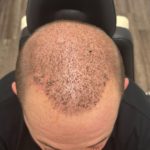
Whether you are considering a hair transplant or eagerly awaiting your upcoming procedure, you may have recently become aware of something called “Shock Loss” which often takes place after undergoing an FUE or FUT hair transplant surgery. Shock loss, also known as ‘shedding’, is an expected, post-procedure process involving hair shedding (before regrowth) that everyone should be aware of when making the exciting decision to move forward with a hair transplant.
What to Expect with Shock Loss After a Hair Transplant?
Shock loss after hair transplant surgery typically begins to occur 2-8 weeks post-procedure, though this can range among patients. During this period, it is very common for patients to experience shedding of the newly transplanted hairs in the recipient area. While less common, patients can potentially see additional shedding in surrounding areas that had not been transplanted or thinning prior to the procedure. Regardless of where you experience the shedding, know that it will grow back.
While this shedding process may initially seem counterproductive to patients who are eager to see the full result of their transplant, or even alarming to those patients who maybe didn’t have the best idea of what to expect, it is important to understand that shock loss is temporary, completely normal, and in no way a reflection of a “failed procedure” or a bigger problem. Rest assured; shock loss is a positive sign that your hair is about to begin a process of new growth.
Why Does Shock Loss Happen After Hair Transplants?
To better understand why shock loss happens, it is important to understand that hair growth is separated into three stages: growth, transition, and resting. During a hair transplant, follicles are surgically removed and repositioned into the scalp, which is considered a traumatic event for the body that can send follicles into the resting phase. In the resting phase, existing hair is completely released by the follicle before it moves forward into the phase of regrowth.
As mentioned above, while it is very common to experience this process of shedding in the newly implanted areas, it is also possible to notice shedding in surrounding areas where non-transplanted hair had also been disturbed by trauma inducing elements of the surgery (including anesthetic injections, incision sites, etc.) It should also be noted that while shock loss is expected and cannot be intentionally avoided, there are patients who experience very little shedding after a transplant as well as some who do not experience any at all.
When Can You Expect to See Regrowth with New Hair?
At Utah Facial Plastics and UFP Hair Restoration, we tell our patients to expect to see regrowth in as soon as 2-3 months. From that point, patients can expect to see full results from their transplant between 9 months to 1 year. The rate of regrowth is not the same for everyone and can sometimes be increased by hair growth medications like Minoxidil or Finasteride, both of which can be prescribed by our doctors.
Our doctors also encourage the use of a hair growth supplement, called Nutrafol, and a hair growth shampoo, called 82S (by Hair Science). Both of which are over-the-counter products that we carry in our offices, yet are very effective.
Shock Loss and Hair Restoration Surgeons
When considering a hair transplant, it is not only important to be aware of aspects of the procedure like shock loss, but also to see a hair restoration surgeon of quality. At UFP, our team of surgeons and advanced hair technicians are here every step of the way to ensure that our patients are well-informed and provided with the highest quality of care throughout their hair restoration journey. Trust Utah Facial Plastics and UFP Hair Restoration to provide you with the knowledge you need, on shock loss and other considerations, and the best results possible.
Additional Resources
- How Common is Hair Transplant Surgery Becoming?
- The Advantages and Disadvantages of Hair Transplant Surgery
- Who Is An Ideal Candidate for the Strip Method or FUT?
- Balding Crown: How To Spot It
- Foods That Can Cause Hair Loss: What to Avoid
- Hair Transplants Actually Look Good Now
Call 801-776-2220 to learn more about shock loss and hair restoration options or schedule a consultation online through a patient care coordinator.